Bsc 2010 Study guides, Class notes & Summaries
Looking for the best study guides, study notes and summaries about Bsc 2010? On this page you'll find 114 study documents about Bsc 2010.
Page 4 out of 114 results
Sort by

-
| LATEST EXAM UPDATES| BSC 2010, Chapters 1-4 Exam 1 Study Guide Questions and answers, rated A+
- Exam (elaborations) • 7 pages • 2024
- Available in package deal
-
- $8.49
- + learn more
BSC 2010, Chapters 1-4 Exam 1 Study Guide Questions and answers, rated A+ Your textbook lists seven characteristics of life as it is known on Earth. What are they? - -Order, Evolutionary Adaptation, Regulation, Energy Processing, Growth and development, Response to the environment, Reproduction Define emergent properties. Give some examples. - -Emergent properties result from the arrangement and interaction of parts within a system (e.g., an organism as a whole has new properties and...
Exam 1 Practice 308Questions & Answers - Integrated Principles of Biology 1 | BSC 2010, Exams for Biology Updated 2023
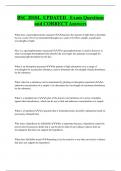
-
BSC 2010L UPDATED Exam Questions and CORRECT Answers
- Exam (elaborations) • 9 pages • 2024
-
- $7.99
- + learn more
What does a spectrophotometer measure?measures the amount of light that is absorbed by (on a scale of 0-2) or transmitted through (on a scale of 0-100) a sample, at particular wavelengths of light How is a spectrophotometer measured?The spectrophotometer is used to discover at what wavelength bromophenol blue absorbs the most light; the optimum wavelength for measuring light absorption by the dye What is an absorption spectrum?the pattern of light absorption over a range of wavelengt...
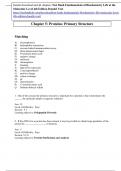
-
BSC 2010C Chapter 5: Proteins: Primary Structure Questions & Answers From The Real Exam |Rated A+.
- Exam (elaborations) • 11 pages • 2024
-
- $8.99
- + learn more
Matching A) electrophoresis B) hydrophobic interaction C) enzyme-linked immunosorbent assay D) three-dimensional shape E) N-terminal amino acid F) negative charge G) nucleases H) chromophore I) foaming J) high level expression K) 2-mercaptoethanol L) positive charge M) cation exchange N) pI O) chymotrypsin P) C-terminal amino acid Q Sodium dodecyl sulfate 1. One of the reasons the primary structure is important for a protein is that it determines the ______ the molecule adopts...
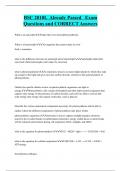
-
BSC 2010L Already Passed Exam Questions and CORRECT Answers
- Exam (elaborations) • 9 pages • 2024
-
- $7.99
- + learn more
What is an autoroph?make their own food (photosynthesis) What is a heterotroph?An organism that cannot make its own food; a consumer what is the difference between an autotroph and a heterotroph?autotrophs make their own food while heterotrophs can't make it's own food what is photorespiration?a respiratory process in many higher plants by which they take up oxygen in the light and give out some carbon dioxide, contrary to the general pattern of photosynthesis
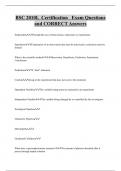
-
BSC 2010L Certification Exam Questions and CORRECT Answers
- Exam (elaborations) • 9 pages • 2024
-
- $7.99
- + learn more
EmpiricallyThrough the use of observations, experience or experiments HypothesisExplanation of an observation that must be tested and a conclusion must be formed What is the scientific method?Observation, Hypothesis, Prediction, Experiment, Conclusions Prediction"If...then" statement ControlGroup in the experiment that does not receive the treatment

-
BSC 2010 EXAM 5 STUDY GUIDE Questions and answers, rated A+| LATEST EXAM UPDATES|
- Exam (elaborations) • 4 pages • 2024
- Available in package deal
-
- $7.99
- + learn more
BSC 2010 EXAM 5 STUDY GUIDE Questions and answers, rated A+ What are telomeres? - -DNA at the tips of chromosomes What are the complementary base pairs of DNA? - -Adenine=Thymine, Guanine=Cytosine Complementary base pairs of RNA? - -Adenine=Uracil, Cytosine=Guanine what is attached to the 5' carbon and 3' carbon ends of the DNA strand? - -phosphate group How is DNA replicated? - -the two strands of DNA unzip, new bases are added (ATGC). What are the enzymes involved in DNA replication? ...
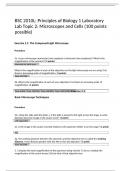
-
BSC 2010L: Principles of Biology 1 Laboratory Lab Topic 2: Microscopes and Cells
- Exam (elaborations) • 7 pages • 2023
-
- $13.99
- + learn more
BSC 2010L: Principles of Biology 1 Laboratory Lab Topic 2: Microscopes and Cells / BSC 2010L: Principles of Biology 1 Laboratory Lab Topic 2: Microscopes and Cells (100 points possible)

-
BSC 2010 Exam |115 Practice Questions with Answers|100 % Correct
- Exam (elaborations) • 16 pages • 2023
-
- $7.99
- + learn more
During which stage of photosynthesis is solar energy converted to the chemical energy of ATP and NADPH, producing oxygen? - ️️Light reactions What is true of elements? - ️️Elements contain only one kind of atom. Isotopes are variants of elements with additional neutrons. Atoms of different elements may not have the same number of protons. All of the atoms of a particular element contain the same number of protons. C, H, and O are the main elements found in organic matter. W...

-
BSC 2010 Exam 1|69 Review Questions With Answers
- Exam (elaborations) • 10 pages • 2023
-
- $7.99
- + learn more
describe how the characteristics of an organism differ from those of non-living thing . - ️️•Organisms acquire and use materials and energy. •Organisms actively maintain organized complexity. •Organisms perceive and respond to stimuli. •Organisms grow. •Organisms reproduce. •organisms, collectively, have the capacity to evolve. Nonliving objects may posses some of these attributes, but only life-forms can do it all. Give an example of a process in the human body that is ...

$6.50 for your textbook summary multiplied by 100 fellow students... Do the math: that's a lot of money! Don't be a thief of your own wallet and start uploading yours now. Discover all about earning on Stuvia



